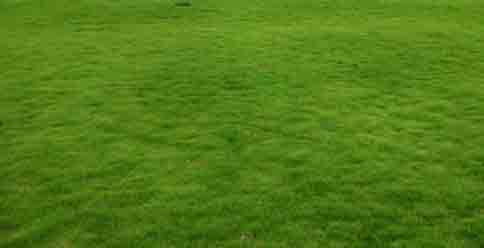Why Korean Lawn Grass is the Unsung Hero of Lawns
Korean lawn grass stands out from the crowd due to its impressive list of benefits:
- Drought Warrior: Korean lawn grass is an expert at keeping water because of its deep root system, which may reach up to two feet. Requiring far less water than other grasses like Bermuda, Fescue, or St. Augustine, it grows well in arid environments. Lower water bills and a smaller environmental impact result from this. Research conducted by the Turfgrass Group has demonstrated how exceptionally drought-tolerant Zoysia is.
- Low-Maintenance Marvel: Bid farewell to perpetual weeding and mowing! Compared to other grass species, Korean lawn grass grows slowly and densely, naturally choking out weeds and requiring less frequent mowing. Research highlighting the low-maintenance nature of Zoysia is supported by North Carolina State University.
- Family-Friendly & Sturdy: This resilient turf can withstand a lot of foot activity from children, dogs, and outdoor events. It is the ideal option for active families because it resists deterioration like a pro.
- Naturally Disease Resistant: Korean lawn grass is immune to a variety of common lawn diseases, enabling you to maintain a healthy lawn without needing to apply pesticides frequently. This saves you money on lawn care components as well as makes it environmentally friendly.
- Coastal Champ: If you reside close to the sea, you are aware of the difficulties caused by the salty air and soil. Korean lawn grass is excellent for houses by the sea since it is immune to salt, and it may even render the most difficult conditions seem lovely.
- Environmental Steward: Not only does Korean lawn grass reduce water, but it also strengthens the soil, prevents soil erosion, and provides habitat for helpful insects—all of which help create an improved environment.
Choosing the Right Korean Lawn Grass Variety for Your Needs
Not all Korean lawn grasses are created equal. Popular varieties like Zenith, Emerald, and Meyer offer unique characteristics:
- Zenith: Known for its fine texture, shade tolerance, and excellent cold hardiness.
- Emerald: A popular choice for its dense growth, vibrant green color, and ability to thrive in full sun.
- Meyer: Highly regarded for its shade tolerance and ability to handle cold temperatures better than other Zoysia varieties.
Consider your local climate, sun exposure, and desired lawn aesthetics when selecting the ideal Korean lawn grass for your yard.
Planting and Caring for Your Korean Lawn Grass
- Soil Preparation: Start with a soil test for pH and nutrient levels. improve the soil as important to create the optimal environment for your Korean lawn grass.
- Planting Methods: You can choose from seeding, sodding. Sodding offers the fastest results, while seeding is more budget-friendly but needs patience. Plugging is the best compromise between cost and speed.
- Watering: Water deeply but infrequently, putting in around one inch of water per week. Adjust watering based on flooding and temperature.
- Aeration and Dethatching: To enhance soil condition and access to water, air out your lawn in the springtime or fall. Every few years, dethatch to get rid of extra thatch accumulation.
Common Mistakes to Avoid with Korean Lawn Grass
- Overwatering: Although Korean lawn grass is drought-resistant it doesn’t need frequent watering. Shallow roots brought on by overwatering can raise the risk of illness.
- Scalping: Your Korean lawn grass will grow more stressed and less able to fend off weeds if you cut it too short.
- Overfertilizing: Too much fertilizer can burn, timber, and contribute to overgrowth in the lawn.
Korean Lawn Grass vs. Other Grasses: The Head-to-Head Comparison
| Feature | Korean Lawn Grass | Bermuda Grass |
| Drought Tolerance | High | Moderate |
| Wear Resistance | High | High |
| Shade Tolerance | Moderate | Low |
| Maintenance Needs | Low | High |
| Water Requirements | Low | Moderate |
| Cold Tolerance | Moderate | Low |
| Establishment Time | Slow (from seed) | Moderate |
| Feature | Fescue Grass | St. Augustine Grass |
| Drought Tolerance | Low | Low |
| Wear Resistance | Moderate | Low |
| Shade Tolerance | Moderate | Moderate |
| Maintenance Needs | Moderate | High |
| Water Requirements | Moderate | High |
| Cold Tolerance | High | Low |
| Establishment Time | Moderate | Moderate |
Cost-Effectiveness of Korean Lawn Grass
For the ecologically conscious homeowner, Korean lawn grass the lawn is a fair economical choice because it takes fewer resources such as water, fertilizer, and upkeep over time, even though the initial cost may be slightly greater than other grasses.
Frequently Asked Questions About Korean Lawn Grass
How fast does Korean lawn grass grow?
One reason Korean lawn grass is attractive among low-maintenance gardeners is that it develops slowly. While sodding offers a more rapid strategy, planting from seed may take several seasons.
Can I plant Korean lawn grass in the shade?
While Korean lawn grass prefers full sun, some varieties like Meyer tolerate partial shade. Consider your yard’s specific conditions when choosing a variety.
Is Korean lawn grass pet-friendly?
Yes, Korean lawn grass is highly durable and can withstand pet traffic without significant damage.
What are the drawbacks of Korean lawn grass?
Korean lawn grass can be slow to establish from seed, and it may require dethatching every few years. It also goes dormant and turns brown in colder climates during winter.
Where can I buy Korean lawn grass?
Korean lawn grass is available at many nurseries and garden centers in Pakistan. You can also purchase it online from reputable seed and sod suppliers.
Ready to Experience the Korean Lawn Grass Difference?
If you decide to transform your lawn into a low-maintenance, environmentally conscious protection, then the Korean lawn grass is the answer.

